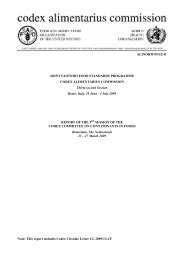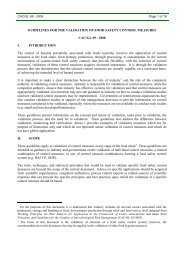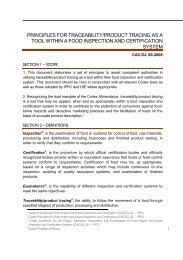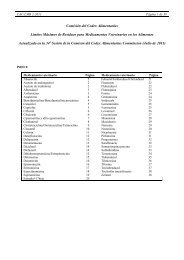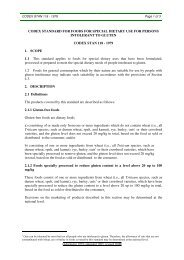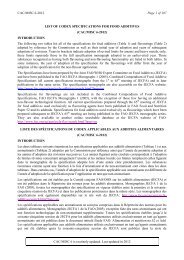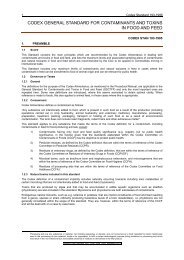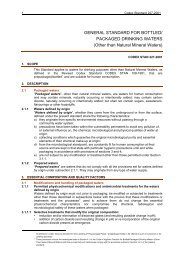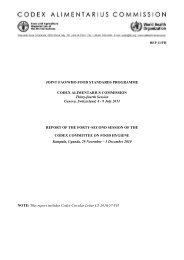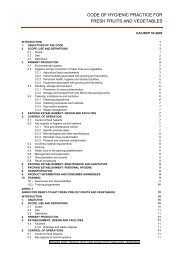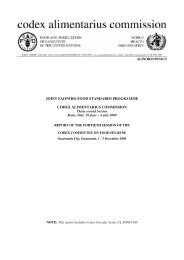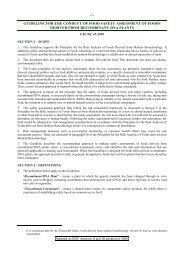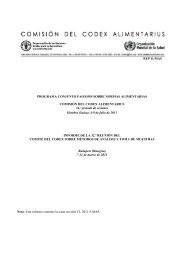General Standard for Food Additives - CODEX Alimentarius
General Standard for Food Additives - CODEX Alimentarius
General Standard for Food Additives - CODEX Alimentarius
Create successful ePaper yourself
Turn your PDF publications into a flip-book with our unique Google optimized e-Paper software.
<strong>CODEX</strong> STAN 192-1995 Page 26 of 287<br />
04.2.1.2 Surface-treated fresh vegetables (including mushrooms and fungi, roots and tubers, pulses and<br />
legumes, and aloe vera), seaweeds, and nuts and seeds:<br />
The surfaces of certain fresh vegetables are coated with glazes or waxes or are treated with other food<br />
additives that act as protective coatings and/or help to preserve the freshness and quality of the vegetable.<br />
Examples include: avocados, cucumbers, green peppers and pistachio nuts.<br />
04.2.1.3 Peeled, cut or shredded fresh vegetables (including mushrooms and fungi, roots and tubers, pulses<br />
and legumes, and aloe vera), seaweeds, and nuts and seeds:<br />
Fresh vegetables, e.g., peeled raw potatoes, that are presented to the consumer to be cooked at home (e.g., in<br />
the preparation of hash brown potatoes).<br />
04.2.2 Processed vegetables (including mushrooms and fungi, roots and tubers, pulses and legumes, and aloe<br />
vera), seaweeds, and nuts and seeds:<br />
Includes all <strong>for</strong>ms of processing other than peeling, cutting and surface treating fresh vegetables.<br />
04.2.2.1 Frozen vegetables (including mushrooms and fungi, roots and tubers, pulses and legumes, and aloe<br />
vera), seaweeds, and nuts and seeds:<br />
43<br />
Fresh vegetables are usually blanched and frozen. Examples include: quick-frozen corn, quick-frozen<br />
French-fried potatoes, quick frozen peas, and quick frozen whole processed tomatoes.<br />
04.2.2.2 Dried vegetables (including mushrooms and fungi, roots and tubers, pulses and legumes, and aloe<br />
vera), seaweeds, and nuts and seeds:<br />
Products in which the natural water content has been reduced below that critical <strong>for</strong> growth <strong>for</strong><br />
microorganisms without affecting the important nutrients. The product may or may not be intended <strong>for</strong><br />
rehydration prior to consumption. Includes vegetable powders that are obtained from drying the juice, such<br />
43<br />
as tomato powder and beet powder. Examples include: dried potato flakes and dried lentil. Examples of<br />
Oriental dried products include: dried sea tangle (kelp; kombu), dried sea tangle with seasoning (shiokombu),<br />
dried seaweed (tororo-kombu), dried gourd strips (kampyo), dried laver (nori), and dried<br />
laminariales (wakame).<br />
04.2.2.3 Vegetables (including mushrooms and fungi, roots and tubers, pulses and legumes, and aloe vera)<br />
and seaweeds in vinegar, oil, brine, or soybean sauce:<br />
Products prepared by treating raw vegetables with salt solution excluding fermented soybean products.<br />
Fermented vegetables, which are a type of pickled product, are classified in 04.2.2.7. Fermented soybean<br />
products are classified in 06.8.6, 06.8.7, 12.9.1, 12.9.2.1 and 12.9.2.3. Examples include: pickled cabbage,<br />
pickled cucumber, olives, pickled onions, mushrooms in oil, marinated artichoke hearts, achar, and piccalilli.<br />
Examples of Oriental-style pickled vegetables include: tsukemono such as rice bran pickled vegetables<br />
(nuka-zuke), koji-pickled vegetables (koji-zuke), sake lees-pickled vegetables (kasu-zuke), miso-pickled<br />
vegetables (miso-zuke), soybeansauce-pickled vegetables (shoyu-zuke), vinegar-pickled vegetables (su-zuke)<br />
and brine-pickled vegetables (shio-zuke). Other examples include: pickled ginger, pickled garlic, and chilli<br />
pickles.<br />
04.2.2.4 Canned or bottled (pasteurized) or retort pouch vegetables (including mushrooms and fungi, roots<br />
and tubers, pulses and legumes, and aloe vera), and seaweeds,:<br />
Fully preserved product in which fresh vegetables are cleaned, blanched, and placed in cans or jars in liquid<br />
43<br />
(e.g., brine, water, oil or sauce), and heat-sterilized or pasteurized. Examples include: canned chestnuts,<br />
canned chestnut puree, asparagus packed in glass jars, canned and cooked pink beans, canned tomato paste<br />
(low acid), and canned tomatoes (pieces, wedges or whole).<br />
04.2.2.5 Vegetable (including mushrooms and fungi, roots and tubers, pulses and legumes, and aloe vera),<br />
seaweed, and nut and seed purees and spreads (e.g., peanut butter):<br />
Vegetable purees are finely dispersed slurries prepared from the concentration of vegetables, which may<br />
have been previously heat-treated (e.g., steamed). The slurries may be filtered prior to packaging. Purees<br />
43,44<br />
contain lower amounts of solids than pastes (found in category 04.2.2.6). Examples include: tomato<br />
43<br />
<strong>Food</strong> Chemistry, H.-D. Belitz & W. Grosch, Springer-Verlag, Heidelberg, 1987, pp. 572-576.<br />
44<br />
Codex <strong>Standard</strong> <strong>for</strong> Processed Tomato Concentrates (<strong>CODEX</strong> STAN 57-1981).



